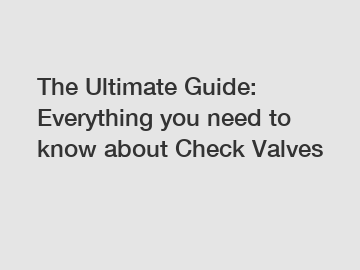The Ultimate Guide: Everything you need to know about Check Valves
CHP contains other products and information you need, so please check it out.
Welcome to the ultimate guide to check valves! Whether you're a professional engineer, a DIY enthusiast, or simply curious about plumbing systems, understanding check valves is essential. In this comprehensive guide, we will cover everything you need to know about check valves, their functionality, types, applications, and maintenance. So, let's dive right in!
Chapter 1: What are Check Valves?

Check valves, also known as non-return valves or one-way valves, are essential components in plumbing and fluid control systems. Their primary function is to allow fluid flow in one direction while preventing backflow. This unique feature ensures safety, prevents contamination, and aids in maintaining system efficiency.
Chapter 2: Types of Check Valves.
There are several types of check valves available, each designed for specific applications. This chapter will discuss the most commonly used types, including:
1. Swing Check Valves: These valves utilize a swinging disc to block reverse flow when fluid pressure drops below the system pressure.
2. Ball Check Valves: Featuring a ball-shaped disc, these valves utilize gravity and/or fluid pressure to seal off flow in the reverse direction.
3. Lift Check Valves: Commonly used in high-pressure applications, they utilize a piston-like disc to regulate the flow of fluids by smoothly lifting and lowering.
4. Tilting Disc Check Valves: Equipped with a tilting disc and spring for responsive operation, these valves are ideal for high flow rates.
5. Stop Check Valves: Combining the features of a lift check valve and a globe valve, these valves provide additional capability to stop flow when necessary.
Chapter 3: Check Valve Applications.
Check valves find extensive use across various industries and systems. In this chapter, we will explore some of their key applications, including:
1. HVAC Systems: Check valves help maintain proper flow and pressure in heating, ventilation, and air conditioning systems, preventing any imbalance or backflow.
2. Oil and Gas Industry: Check valves play a vital role in ensuring the safety and efficiency of pipelines, controlling flow, and preventing accidents.
3. Water Treatment: They help regulate water supply systems, maintaining adequate pressure and avoiding contamination caused by backflow.
4. Plumbing Systems: Check valves are installed in residential and commercial plumbing to prevent backflow and protect against cross-contamination.
Chapter 4: Check Valve Maintenance and Safety.
Proper maintenance is critical to ensure the longevity of check valves and the overall efficiency of the systems they are installed in. This chapter delves into essential maintenance tips and safety considerations, including:
1. Regular Inspection: Conduct routine checks to ensure the valves operate smoothly, without any leaks or signs of wear.
2. Cleaning and Lubrication: Keep the valves clean and properly lubricated to minimize friction, corrosion, and ensure smooth operation.
3. Proper Installation: Follow manufacturer guidelines to install check valves correctly, ensuring they are aligned with the flow direction.
4. Safety Measures: Be cautious when closing or opening check valves, as sudden pressure changes may cause system damage or injury.
Chapter 5: Trouble Shooting and FAQs.
In this final chapter, we address common troubleshooting scenarios and frequently asked questions relating to check valves. From identifying and fixing leaks to understanding peculiar valve behavior, we've got you covered.
Conclusion:
Understanding the importance and functionality of check valves is crucial for anyone involved in fluid control systems. In this comprehensive guide, we have explored the various types, applications, maintenance, and safety considerations associated with check valves. Armed with this knowledge, you can confidently undertake plumbing projects, safeguard industrial systems, and ensure the efficient functioning of HVAC or water treatment systems. Stay check valve savvy – and always remember to maintain, inspect, and troubleshoot for optimal performance!
Please visit our website for more information on this topic.
Contact us to discuss your requirements of forged fitting. Our experienced sales team can help you identify the options that best suit your needs.



